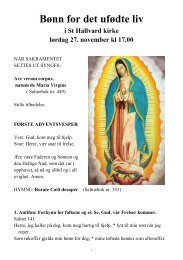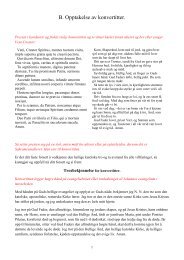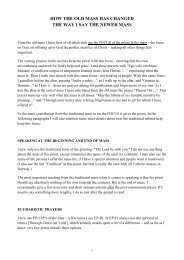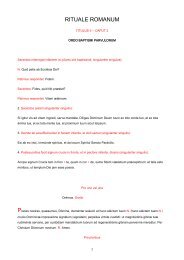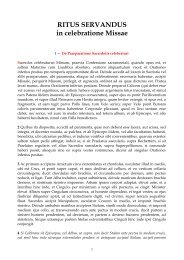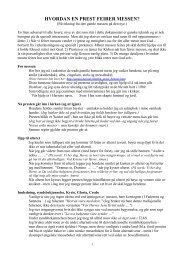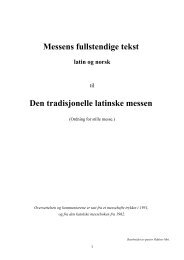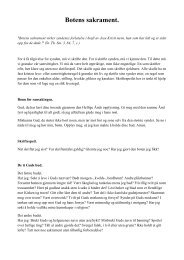oppgaven finner man i sin helhet her
oppgaven finner man i sin helhet her
oppgaven finner man i sin helhet her
Create successful ePaper yourself
Turn your PDF publications into a flip-book with our unique Google optimized e-Paper software.
the S.C.R., 3 September 1958, n.70.”)”<br />
Pave Paul VI refererte til Musicam Sacram i <strong>sin</strong>e offentlige uttalelser så sent som i 1977 19,<br />
og indikerte at dette dokumentet ikke bare gjaldt messen slik den var før endringene i<br />
1970 og 1975, men at bestemmelsene også gjaldt for liturgien etter 1970.<br />
9) Kongregasjonen for Gudstjenesten og Sakramentsordningen: Liturgicae<br />
instaurationes (3. instruksjon til konsilets liturgikonstitusjon, 1970)<br />
Den tredje instruksjonen til konsilets liturgidokument gir også praktiske retningslinjer<br />
til prester og lekfolk i liturgien, i tillegg til at det nevnes visse misbruk som har<br />
forekommet siden forrige instruksjon og som ønskes avskaffet. Kirkemusikken har noe<br />
større plass <strong>her</strong> enn i de to forrige skrivene, og <strong>man</strong> bekrefter på nytt det som allerede har<br />
blitt uttrykt om emnet av tidligere paver (fotnotene i originalen refererer til de tidligere<br />
dokumenter):<br />
”3. (…) b. Sources for the entrance and communion antiphons are: the Graduale<br />
ro<strong>man</strong>um, The Simple Gradual, the Ro<strong>man</strong> Missal, and the compilations approved by the<br />
conferences of bishops. In choo<strong>sin</strong>g chants for Mass, the conferences should take into<br />
account not only suitability to the times and differing circumstances of the liturgical<br />
services, but also the needs of the faithful u<strong>sin</strong>g them.<br />
c. Congregational <strong>sin</strong>ging is to be fostered by every means possible, even by use of new<br />
types of music suited to the culture of the people and to the contemporary spirit. The<br />
conferences of bishops should authorize a list of songs that are to be used in Masses with<br />
special groups, for example, with youth or children, and that in text, melody, rhythm, and<br />
instrumentation are suited to the dignity and holiness of the place and of divine worship.<br />
The Church does not bar any style of sacred music from the liturgy. Still, not every style<br />
or the sound of every song or instrument deserves equal status as an aid to prayer and an<br />
expression of the mystery of Christ. All musical elements have as their one purpose the<br />
celebration of divine worship. They must, then, possess sacredness and soundness of form,<br />
fit in with the spirit of the liturgical service and the nature of its particular parts; they<br />
must not be a hindrance to an intense participation of the assembly but must direct the<br />
mind's attention and the heart's sentiments toward the rites.”<br />
8) Uttalelser fra pave Paul VI og andre autoriteter<br />
I årene som fulgte etter 2. Vatikankonsil uttalte pave Paul VI seg <strong>man</strong>ge ganger om<br />
liturgisk musikk, i likhet med andre kirkelige autoriteter. I disse uttalelsene fastholdte han<br />
19 Pave Paul VI: Tale under den 10. internasjonale kirkekorkongressen, Notitiae 6 (1970) s. 309-<br />
310. Notitiae, med undertittelen Commentarii, er det offisielle månedlige tidsskriftet til<br />
Kongregasjonen for Gudstjenesten og Sakramentsordningen. Det gir ut alle Vatikanets offisielle<br />
uttalelser og dokumenter om liturgi.<br />
Pave Paul VI: Homili til medlemmene av Associazione Italiana di Santa Cecilia, Notitiae 13 (1977), s.<br />
475.<br />
22<br />
22



